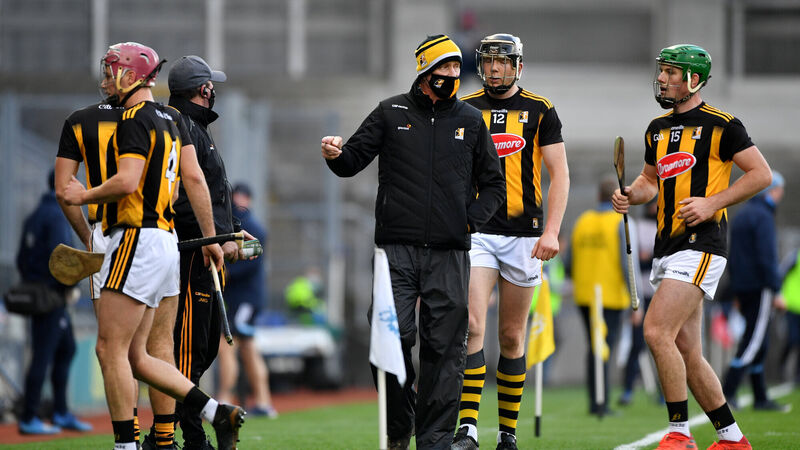Eimear Ryan: Kilkenny comeback was a thrilling plot twist in the drama that is Championship 2020

Kilkenny manager Brian Cody speaks to his players at the water break during the Leinster semi-final win over Dublin. Picture: Daire Brennan/Sportsfile
And then there were six. The rapidly narrowing field of All-Ireland hurling contenders now contains four teams from Munster and two from Leinster. At the weekend, while many were live-tweeting their binge-watch of Netflix’s , we hurling folks had our own viewing marathon: streaming the qualifier then switching to RTÉ for the camogie then to Sky for the other qualifier then back to RTÉ for the Leinster final.
It reminded me, in a strange way, of election night: the channel-hopping, the breathless commentary, the spiking cortisol levels, Jamesie O’Connor at the giant Sky Sports iPad like a slightly less animated Steve Kornacki. And just like in the wake of the election, now the number-crunching and the parsing of possible permutations begins.
Pending the outcome of Saturday’s quarter-finals, we have a Rubik’s cube of possibilities to consider. Will the All-Ireland final feature Galway or Kilkenny, as it has every year but one since 1998?
Or will we ultimately be looking at a Munster Mash? (Let me have that one, I’ve been saving it since Halloween.)
It’s hard to say ‘never’ when it comes to this pairing, but it probably won’t be a Tipp-Kilkenny final; if Tipp manage to beat Galway on Saturday, they’ll most likely play Kilkenny in the semi, since they can’t be drawn against Limerick again.
Of the six All-Ireland deciders that Tipp have contested since 2009, they have met Kilkenny in every single one. It would feel strange to watch the two sides play without someone lifting a cup afterwards.
As a Tipp supporter who has watched every episode in the ongoing psychodrama between ourselves and Cats unfold over the past decade or so, it was nice to get so much enjoyment out of Kilkenny’s win on Saturday night.
You couldn’t but clap your hands in glee at Richie Hogan’s goal, a bit of dainty genius – blind to the chaos of bodies around him, eyes only for the ball. The instinctive nature of his playing style – out in front, win it, pivot – is a thrill to watch.
His impact in a little under half an hour on the pitch was something else. Quite apart from the goal, he distributed the ball prolifically and popped over two crucial points, one which could easily have been a second goal.
Maybe you only get one impact substitution like that per season; curtailing his influence will be a priority for any team facing Kilkenny from here on out. But boy, did he make the most of it.
There’s a particular pleasure in watching a game where you don’t mind who wins.
Rather than cheering for nobody, you end up shouting for both teams. And what made Kilkenny’s comeback on Saturday evening so special was there was no crushing inevitability about it.
It was not the predictable hammer blow of a dominant force, as it has been in years past, but an inspired plot twist. Even after TJ Reid’s quick follow-up goal, I still felt that Galway would weather the storm.
Theirs was a solid and calm performance, if ultimately lacking in the pizzazz department. It will be interesting to see if, when meeting Tipp next weekend – who have also failed to set the championship alight as yet – something might finally ignite for both sides.
The narrative that Kilkenny are entering a new era, notably finishing out the game without big guns Walter Walsh and Colin Fennelly, is tempered somewhat by the fact that it was the old guard of Richie Hogan and TJ Reid who sparked the comeback.
As refreshed as their panel looks in many ways (21-year-old Niall Brassil looked lively in his championship debut, crossing a couple of deadly-accurate passes into the scoring zone towards the finish), the fact that Darth Cody still presides over it all puts a caveat on any ideas of a ‘new Kilkenny’.
In his post-match interview, the Kilkenny manager was even more inscrutable than normal under his black-and-amber mask and woolly hat, although there seemed to be a bit of crinkling around the eyes. Twinkling, even. (Was he … pleased?) Joanne Cantwell, for one, wasn’t fooled.
Transitioning to an ad break, she remarked: "In terms of tactics, the times they are a-changing, but in terms of who’s bringing home the silverware, it’s pretty much the same as it has been for many, many years in the recent past."
Her jadedness was a nice counterpoint to Henry Shefflin’s palpable delight at the Kilkenny display.
As much as we have to look forward to over the coming weeks, last weekend also brought home the grim realisation, as highlighted by John Kiely, that many panellists are not getting the opportunity to be present with their team on match day.
Current government measures meant that each county can only bring 40 on the day: 26 players, 12 backroom staff and two county officials. As Kiely pointed out, this means he has to leave 10 players at home, watching the game on the couch like the rest of us.
Players on the margins of panels already feel, well, marginalised; this type of treatment is desperate for morale.
It’s highly unlikely that anything will change in time for the semi-finals, but one would hope that if government measures are reviewed in early December, panels will be allowed a greater capacity for the All-Ireland final at least.
Clearly there have to be social distancing standards, but if you can’t accommodate 20 extra bodies in empty stadiums built for 50,000 and more, there is something very wrong.
Playing inter-county hurling is a public service at the best of times, but never more so than this year, when it’s given us texture, colour, entertainment and distraction.
In a time when we’re sorely lacking in all of the above, we can’t thank or praise these players enough. The privilege of attending their own matches is the very least they deserve.








